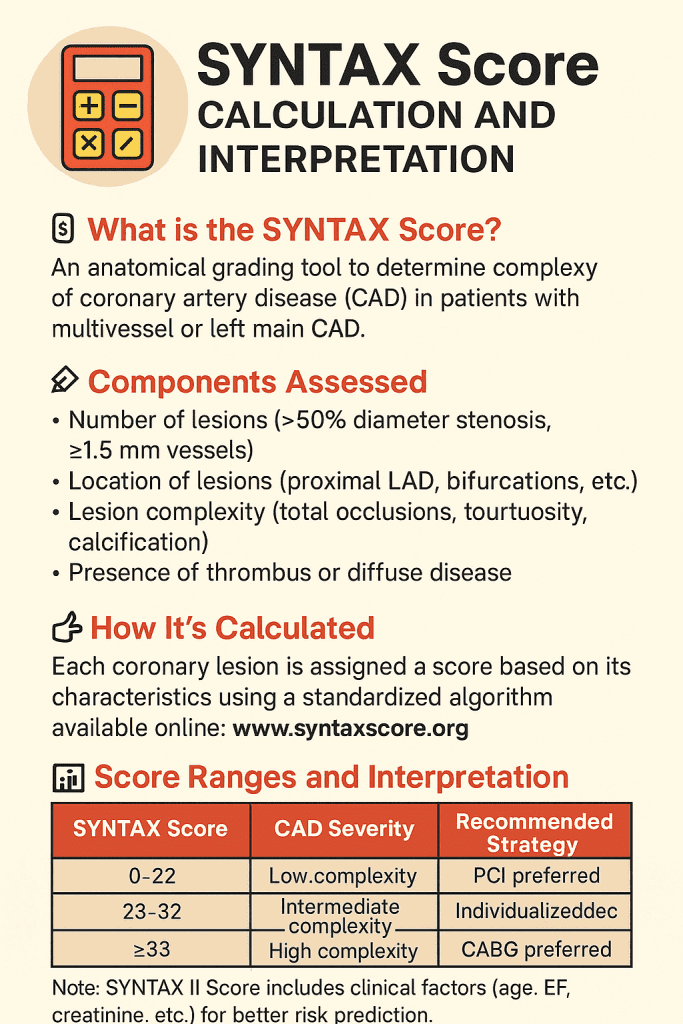SYNTAX Score Calculation
SYNTAX Score Calculation
🔢 What is the SYNTAX Score?
The SYNTAX score is an anatomical grading tool to determine the complexity of coronary artery disease (CAD) in patients with multivessel or left main CAD. It helps guide treatment decisions between PCI and CABG.
📌 Components Assessed
- Number of lesions (>50% diameter stenosis, ≥1.5 mm vessels)
- Location of lesions (proximal LAD, bifurcations, etc.)
- Lesion complexity (total occlusions, tortuosity, calcification)
- Presence of thrombus or diffuse disease
🧮 How It’s Calculated
Each coronary lesion is assigned a score based on its characteristics using a standardized algorithm available online.
👉 Use the official SYNTAX calculator: www.syntaxscore.org
📊 Score Ranges and Interpretation
| SYNTAX Score | CAD Severity | Recommended Strategy |
|---|---|---|
| 0–22 | Low complexity | PCI preferred |
| 23–32 | Intermediate complexity | Individualized decision |
| ≥33 | High complexity | CABG preferred |
Note: SYNTAX II Score includes clinical factors (age, EF, creatinine, etc.) for better risk prediction.
SYNTAX I Score
SYNTAX II Score

SYNTAX score, a tool used in cardiology to quantify the severity of coronary artery disease based on its anatomical complexity.
Here’s a breakdown of the notation:
- SYNTAX: This signifies the SYNTAX score itself.
- >50% diameter stenosis: This refers to the degree of narrowing or blockage in a coronary artery. Specifically, it means the lesion causes a reduction of more than 50% in the vessel’s diameter.
- vessel size >1.5 mm: This refers to the diameter of the coronary artery itself. Only lesions in vessels larger than 1.5mm are considered for the SYNTAX score calculation.
Therefore, “Syntax >50% diameter vessel size >” indicates that the report is describing a coronary lesion that is significant (causing more than 50% narrowing) and located in a major vessel (larger than 1.5 mm in diameter) that will be included in the calculation of the overall SYNTAX score.
Additional details about the SYNTAX score
- The SYNTAX score is lesion-based, meaning each lesion is scored separately, and the total score is the sum of these individual scores.
- The score also considers other characteristics of the lesion, such as its location within the coronary tree, the presence of total occlusions, bifurcations, trifurcations, and other factors that reflect the complexity of the disease.
- The SYNTAX score helps guide treatment decisions for patients with multivessel coronary artery disease, with higher scores suggesting that coronary artery bypass graft (CABG) surgery might be more beneficial than percutaneous coronary intervention (PCI).
- While a 50% narrowing is the threshold for including lesions in the SYNTAX score, the ESC/EACTS guidelines on myocardial revascularization and other studies define moderate stenosis as 50-69% and severe stenosis as 70-99% for most coronary arteries. The left main coronary artery has a lower threshold, with >50% stenosis considered significant.
In essence, “Syntax >50% diameter vessel size >” in a medical report would be interpreted as a significant finding, indicating a significant blockage in a major coronary artery that contributes to the patient’s overall SYNTAX score and risk assessment.


